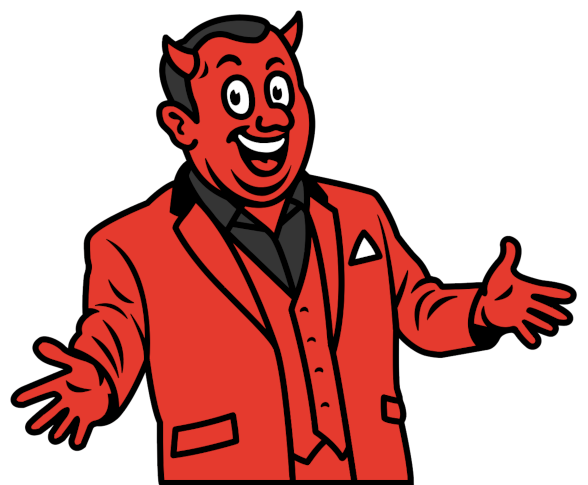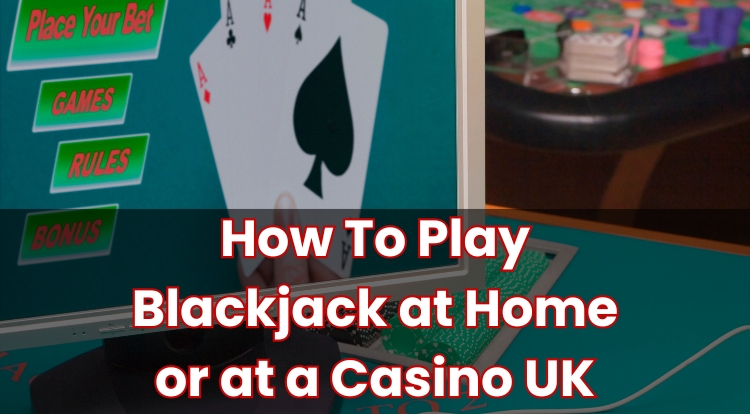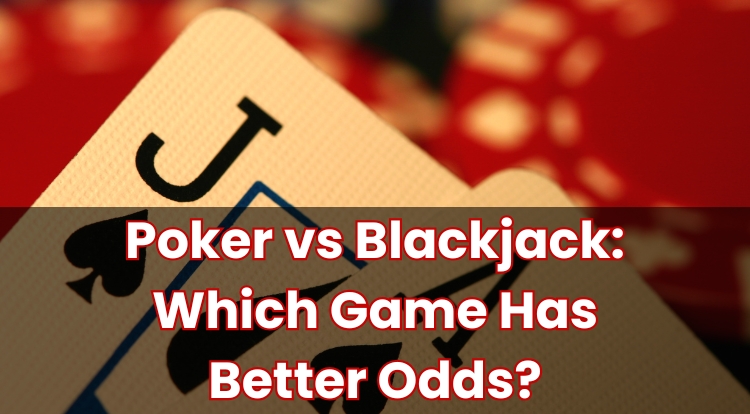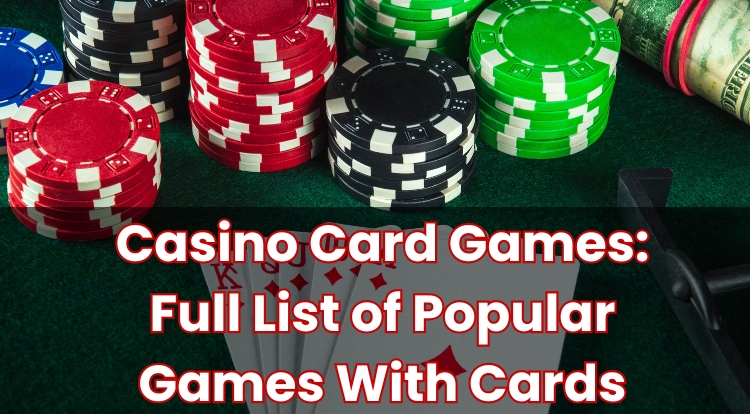How To Play Blackjack – A Beginners Guide
Blackjack is a card game that combines skill and chance at the casino table. Suitable for beginners, the goal of the game is simple: achieve a hand value closer to 21 than the dealer without going over.
Understanding the basics of blackjack may benefit a player’s gaming experience. With its quick pace and straightforward rules, it is a game that may appeal to those interested in casino games.
In this guide, there will be step-by-step instructions to try and help new players navigate their way through a game of blackjack, from the initial deal to common strategies.
What Is Blackjack?
Blackjack is a popular card game found in both online and land-based casinos. Its appeal may lie in the combination of chance and strategic decision-making that is involved in its gameplay.
The game is typically played with one or more standard decks of 52 cards. Each card has a value: numbered cards are worth their number, face cards (kings, queens, and jacks) are each worth 10, and aces can be worth either 1 or 11, depending on which is more favourable for the player at the time.
The main objective is straightforward. Players aim to have a hand value closer to 21 than the dealer’s hand, without exceeding 21. If the total value goes over 21, this is called a “bust,” and the player loses the round.
Players begin by placing a bet, and then both the player and dealer receive two cards. Typically, the player’s cards are dealt face up, while the dealer has one card face up and the other face down.
Blackjack Rules Explained
Blackjack rules are quite simple, which may help make it appeal to beginners. Each game of blackjack involves the player and the dealer. The objective is to have a hand value closer to 21 than the dealer’s hand without exceeding it.
At the beginning of the game, the player places a bet. Following this, both the player and the dealer receive two cards each. The player’s cards are usually face up, while the dealer has one card face up and one face down.
The player then decides whether they would like to “hit” (receive another card) or “stand” (keep their current hand). The aim is to get as close as possible to 21 without going over, which is known as “busting.”
If the player’s hand value exceeds 21, they automatically lose the round. If the player and dealer have the same hand value, it is a “push,” and the player’s bet is returned.
After the player decides to stand, it’s the dealer’s turn to play. The dealer will reveal their face-down card and must continue to hit until their hand reaches at least 17. If the dealer busts, the player wins the round.
Hitting
Hitting is one of the fundamental actions a player may take in blackjack. If a player chooses to hit, they are asking for an additional card from the dealer.
The purpose of hitting is to increase the total value of the player’s hand. This decision is typically made if the player believes that their current hand is too low to win against the dealer’s possible hand.
However, players may want to carefully consider whether their hand may be able to take another card. If the new card causes the total value to exceed 21, the player will bust and lose the round.
Deciding whether to hit requires evaluating the current hand value and the dealer’s visible card. Balancing the desire for a higher hand value with the chance of busting may affect a player’s success.
Standing
Standing may be an important decision if playing blackjack. If a player chooses to stand, it typically means they are satisfied with their current hand and do not wish to receive any more cards.
This action is usually taken if the player believes that any additional card may lead to a bust, or if the hand is strong enough to potentially beat the dealer’s hand.
Once a player stands, their turn ends. They must wait for the dealer to play their own hand.
Choosing when to stand may require careful consideration of the player’s hand value and the dealer’s visible card. Understanding when to stand may influence the outcome of the game in the player’s favour.
Splitting
Splitting is a unique option in blackjack that may allow players to turn one hand into two separate hands. This choice becomes available when a player is dealt two cards of the same rank, such as two 8s or two 5s.
If a player wants to split, they place an additional bet equal to their original bet. Each card is then used as the first card in two new hands.
Once the cards are split, the player plays each hand separately. They may hit, stand, or even double down on each hand, depending on their card values.
Splitting has the chance to be a strategic move and may potentially give the player a better chance against the dealer. However, knowing whether or not to split may be beneficial. For example, splitting might be advantageous with pairs like 8s and aces, but less so with 10s.
Doubling Down
Doubling down is a strategic move in blackjack that allows a player to increase their original bet by up to 100% in exchange for committing to stand after receiving one additional card.
This option is typically used if the player believes that a single additional card will give them a strong hand. It is most commonly considered if the player has a hand value of 9, 10, or 11, as these totals may have a chance of forming a strong hand with one more card.
If a player wants to double down, they place an additional bet equal to their initial bet. After receiving one additional card, their turn ends, and they must stand with their new total.
What Is The Ace Worth?
In blackjack, the ace is a versatile card due to its flexible value. It can be worth either 1 or 11, depending on which value benefits the player’s hand most.
At the start of a game, the ace is typically valued at 11 if doing so keeps the hand value at or below 21, as this provides the strongest option. This type of hand is referred to as a “soft hand,” meaning it cannot bust with the addition of one card.
However, if a player’s hand exceeds 21 with the ace valued at 11, it automatically adjusts to being worth 1, turning the hand into a “hard hand.” This flexibility may be a strategic advantage, allowing the player to adapt their hand as new cards are drawn.
Recognising how to count an ace’s value may be beneficial for any blackjack player, as it may play a role in deciding whether the player wants to hit or stand.
Blackjack Odds and Payouts
Understanding blackjack odds and payouts may be useful for players aiming to make informed decisions during a game. Blackjack may offer some of the best odds in the casino, which is part of what makes it a popular choice among players.
A standard win tends to pay 1:1. This means if a player bets £10 and wins, they may be awarded £10, plus their original bet back.
A hand that totals exactly 21 on the first two cards—a blackjack—tends to receive a higher payout. Most casinos offer a payout of 3:2 for a blackjack. Thus, a £10 bet may award £15, in addition to the initial bet.
It may be important to note that if the dealer also has a blackjack, it results in a “push,” and the player’s bet is returned.
Players may also want to be aware of insurance bets. If the dealer’s face-up card is an ace, players may be given the option to place an insurance bet, typically paying 2:1. However, it’s important to note that this, like all bets, does not come without its risks.
Blackjack Side Bets Explained
Blackjack side bets are optional wagers that players may place in addition to their main bet. These bets add an extra dynamic to the game by giving players the chance to bet on potential outcomes beyond the main game.
While side bets offer the chance for potential winnings, they often come with higher house edges. As with all bets, players should keep responsible gambling practices in mind, especially as side bets tend to be independent of the main game outcome.
Insurance Bets
Insurance bets are a specific type of side bet in blackjack. This option becomes available when the dealer’s face-up card is an ace, which indicates a high chance the dealer might have a potential blackjack.
The player may choose to place an insurance bet, which is half the original bet. This side bet typically pays 2:1 if the dealer’s hidden card indeed makes a blackjack.
The purpose of insurance is to potentially protect the player’s original bet in case the dealer has a blackjack. However, it’s important to note that if the dealer does not have a blackjack, the player loses the insurance bet, even if they win the round.
21+3
The 21+3 side bet in blackjack may allow players to wager on a combination that involves their first two cards and the dealer’s face-up card. This bet is based on forming specific poker-style hands.
If the three cards create a “flush” (same suit), “straight” (consecutive ranks), “three of a kind” (same rank), “straight flush” (consecutive ranks, same suit), or a “suited three of a kind” (same rank and suit), the player wins the 21+3 bet.
The payouts for this bet may vary depending on the hand’s rarity and the casino’s specific rules. For instance, a straight flush might have a higher potential payout than a simple flush.
While 21+3 may add another dynamic to the game, it generally comes with a higher house edge compared to the main blackjack game. Players may want to consider this when deciding whether to place the side bet. Understanding the factors involved with 21+3 may help players make more informed choices during gameplay.
Perfect Pairs
The perfect pairs side bet in blackjack is a popular option for those who might want to add another dynamic to their game. This bet focuses on the player’s initial two cards and whether they form a pair.
There are three types of pairs a player may have: a “perfect pair” (same rank and suit), a “coloured pair” (same rank and colour, different suits), and a “mixed pair” (same rank, different suits).
Potential payouts for the perfect pairs bet may vary based on the type of pair achieved. A perfect pair typically offers the highest payout, followed by a coloured pair and a mixed pair.
Although the chance of forming a pair may offer potentially rewarding payouts, it’s important to understand that the house edge on this bet may be higher than in standard blackjack play. Players should keep this in mind when placing a perfect pairs bet and, as with all betting, remember to keep responsible gambling practices in mind.
What Is The Best Blackjack Strategy?
While there are strategies involved in blackjack, it’s important to note that blackjack ultimately involves chance, and no strategy can overcome that factor.
That being said, it may be beneficial for a player to have a strategy that involves fully understanding when to hit, stand, split, or double down based on their hand and the dealer’s visible card. This approach has the chance to minimise the house edge and potentially enhance the player’s chances at success.
A widely recommended method for beginners is the basic strategy chart. This chart provides instructions on potential moves to make for every possible hand combination, given the dealer’s upcard.
Taking the time to memorise or consult this chart may be beneficial and may help players make informed decisions throughout the game.
It’s important to remember that while the basic strategy may improve a player’s odds, it cannot guarantee a win. Variability is part of the game, and all strategies involve an element of chance.
Practising blackjack with the basic strategy in different settings, like online games or free apps, may help players understand the game better and apply what they’ve learned in a real game scenario.
Play Blackjack Online
Want to explore blackjack from the comfort of your home? At 666Casino, players may experience the game with just a few clicks, accessing a wide variety of blackjack tables suitable for all skill levels and budgets.
Our platform is designed to offer a seamless experience, making it ideal for beginners who are interested in trying their hand at this classic card game. With detailed guides and user-friendly interfaces, 666Casino helps players feel at ease as they learn the ins and outs of blackjack.
Joining 666Casino gives players the opportunity to enjoy the classic game of blackjack in an online environment. It’s ideal for players who are interested in practicing strategies and playing at their own pace.
FAQs
In this section, common questions about playing blackjack will be addressed. These FAQs aim to provide clarity and help beginners feel more confident as they start playing.
The answers will cover a range of topics, from basic rules to strategies and general gameplay tips. Players may use this information to enhance their understanding and improve their chances of success at the blackjack table.
When Should I Hit In Blackjack?
Deciding to hit in blackjack may be an important part of the game. Generally, a player may want to hit if their hand value is low and there’s a chance of improving the hand without busting.
For instance, if a player’s hand totals between 12 and 16 and the dealer’s visible card is high, such as a 7 or above, hitting might be advisable. These situations suggest a potentially weaker hand compared to the dealer’s potential hand.
On the other hand, if holding a hand of 17 or more, it’s usually safer to stand. The risk of busting with a high initial hand typically outweighs the potential benefit of hitting.
Players may also refer to a basic strategy chart, which may provide recommendations based on the player’s hand and the dealer’s upcard. This chart may help players make informed decisions about hitting.
Deciding whether to hit or not is about finding the right balance between improving the hand and minimising the risk of going over 21. With practice, players may develop the confidence to make these decisions.
When Should I Stand?
Deciding whether to stand or not may be an important part of playing blackjack. A player typically stands if their hand is strong enough to potentially beat the dealer’s hand or if the chance of busting with another card is too high.
It is generally advisable for a player to stand if their hand total is 17 or higher. At this point, the chances of busting with another card tend to increase significantly, especially if the dealer shows a low card, suggesting they might also struggle to reach a strong hand.
Another situation where standing might be wise is if the player has a “hard” hand (a hand without an ace or with an ace that must count as 1) totalling between 12 and 16, and the dealer’s upcard is 4, 5, or 6. In such cases, the dealer’s possibilities of busting increase, making standing a potential tactical choice.
Learning to recognise these scenarios may help a player make more informed decisions and potentially improve their outcomes in the game.
When Should I Split?
Knowing when to split in blackjack may play a part in playing the game well. Players may want to consider splitting when they are dealt a pair, as it may enhance their potential for a stronger hand.
A common strategy is to always split aces and 8s. Splitting aces provides two opportunities to potentially hit a strong hand, while splitting 8s helps avoid a total of 16, which is a weak hand.
On the other hand, players may generally want to avoid splitting 10s or face cards. A hand totalling 20 is already strong, and splitting 10s can reduce the chance of winning.
Ultimately, deciding when to split requires looking at the dealer’s upcard as well. Players should weigh up their current hand value and the possible outcomes before making a decision.
What Is a Blackjack?
A blackjack is the best possible hand a player can have in the game of blackjack. It consists of an ace and any ten-point card (10, jack, queen, or king) dealt as the initial two cards. This specific combination totals exactly 21, giving it its special name.
If a player is dealt a blackjack, it typically results in an automatic win for that round unless the dealer also has a blackjack. In that case, the round ends in a “push,” meaning the player’s bet is returned.
The payout for a blackjack is usually 3:2, which means if a player bets £10, they may be awarded £15 plus their original bet back.
Understanding what constitutes a blackjack may be beneficial to players, as it may help in recognising if they have achieved this hand and the benefits it may bring in terms of both strategy and potential outcomes.
*All values (Bet Levels, Maximum Wins, etc.) mentioned in relation to these games are subject to change at any time. Game features mentioned may not be available in some jurisdictions.
**The information provided in this blog is intended for educational purposes and should not be construed as betting advice or a guarantee of success. Always gamble responsibly.





